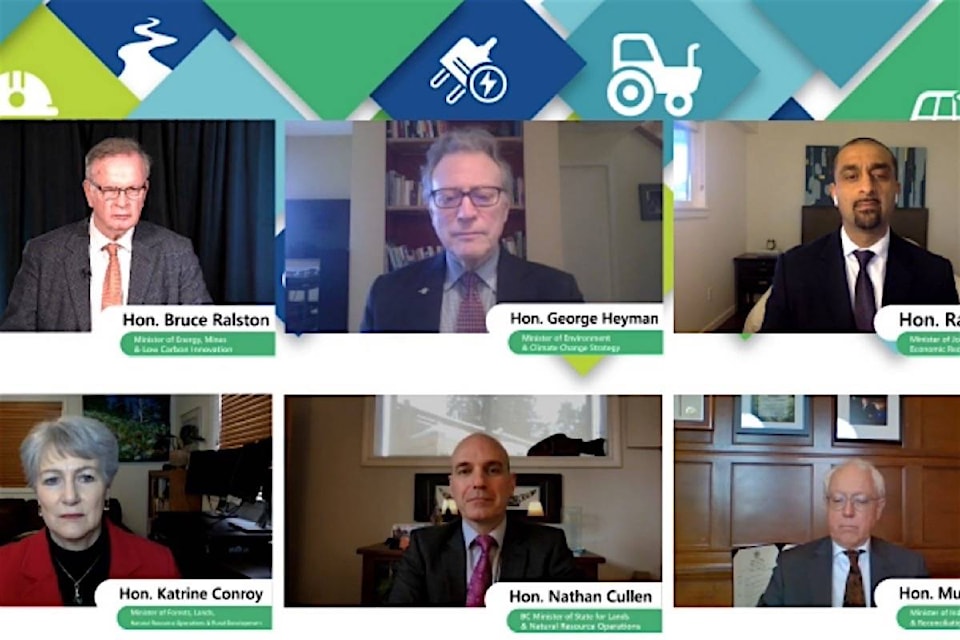B.C.’s advantages as a low-carbon, Indigenous rights-sensitive jurisdiction with an abundance of clean electricity, metals, minerals and natural gas were the talk of the B.C. Natural Resources Forum this week. But one big disadvantage kept coming up.
Participants in the annual forum, held online from Vancouver instead of its usual host city of Prince George, were greeted by an array of five cabinet ministers and one minister of state in charge of resource development permits. And as the moderator twice reminded them during the cabinet ministers panel, it currently takes an average of 13 years to go from investment decision to approval of a new mine in B.C.
Premier John Horgan acknowledged the problem in his address to the forum Thursday, describing the latest government reorganization to get ministries working together better to rebuild after the COVID-19 pandemic.
“What we need to do is retool our permitting process,” Horgan told the forum from his office in Victoria Jan. 28. “The days of let ’er rip are gone. The days of responsible development have arrived.”
Premier @jjhorgan speaks to @BCNRF, describing his plan to break the logjam of resource permits #bcpoli #bcleg pic.twitter.com/lOV1sHhFpV
— Tom Fletcher (@tomfletcherbc) January 28, 2021
Forests Minister Katrine Conroy and Environment Minister George Heyman acknowledged the long-standing permit logjam, both saying the core issue is insufficient government staff to deal with permits in an increasingly complex world. B.C. is attempting to lead the country in implementing the UN Declaration of the Rights of Indigenous Peoples, starting with a new environmental assessment that requires Indigenous partnership before the application is even submitted.
Heyman said he was warned by now-retired forests and lands minister Doug Donaldson that without sufficient ministry staff to get permits done, a long backlog is inevitable. The problem goes back to the early years of the Gordon Campbell government, which created the mega-ministry the NDP government is preparing to break up. It was first raised by former B.C. Liberal minister George Abbott, who has since written a book on the topic entitled Big Promises, Small Government.
Skeena MLA Nathan Cullen’s assignment is to build a sixth ministry to deal with land and resource management, covering 95 per cent of the province and grappling with road impacts on caribou as well as the environmental risks of mining and logging.
“We want to make it easier for good products to come to market,” Cullen told the resource forum.
Energy and Mines Minister Bruce Ralston noted that mine projects awaiting approval include Blackwater gold mine south of Vanderhoof, a restart of the Eskay Creek gold mine in Tahltan territory in the far northwest, and an extension of Highland Valley Copper south of Ashcroft.
RELATED: B.C. mine executives see bright gleam in future
RELATED: Copper Mountain has expansion plans for 2021
Ralston said B.C. is well positioned for “ESG investment,” which stands for environmental, social and governance considerations in addition to a return to shareholders. He referred to the latest annual letter to CEOs from Larry Fink, head of Blackrock, the world’s largest asset manager with $7 trillion in investments. Fink announced that environmental sustainability will become more important as the world economy emerges from the COVID-19 pandemic.
B.C. Hydro continues work on its increasingly costly Site C dam, with highway closures again this weekend to move a second huge water turbine from Prince Rupert to the site near Fort St. John. The federal government has committed $85 million for B.C. to shift industries using carbon fuels to electricity, with a key user of Site C power being the oil and gas industry.
“Whether it’s mining or the gas sector, we’re seeing innovation,” due to B.C.’s early adoption of a carbon tax, said Heyman, who headed Sierra Club B.C. before becoming an NDP MLA.
One of the biggest disruptions in B.C. resource projects has been objections from Indigenous communities. Taking questions from Kendra Johnston, CEO of the Association of Mineral Exploration B.C., Horgan said one of the biggest problems of the pandemic is a lack of progress with Wet’suwet’en people disputing the LNG Canada project, the largest private sector investment in B.C. history. With in-person meetings halted due to COVID-19, improving online connectivity with the scattered, remote communities of B.C.’s north is a high priority for the 2021 B.C. budget, he said.
Former NDP MP and law professor Murray Rankin is B.C.’s new Indigenous relations minister, who has to make all B.C. laws consistent with the UN declaration, as directed by legislation passed before the pandemic. He told the forum that B.C.’s transformation means moving from “transactional agreements” on resource development to one based on human rights and self-government for the more than 200 Indigenous communities in B.C.
“We’re trying to create an environment where people are confident in investing,” Rankin said.
@tomfletcherbc
tfletcher@blackpress.ca
Like us on Facebook and follow us on Twitter.
